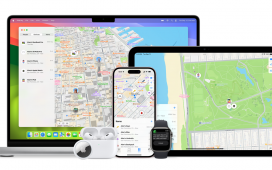The Pico-mac-nano stands 2.4 inches tall and features a 2-inch, 480×640-pixel LCD screen.
The original 1984 Apple Macintosh — which stood more than 13 inches high and weighed 16.5 pounds — was anything but portable, at least by today’s standards. The same can hardly be said of a teeny new functional replica of the iconic computer. It’s about the size of a matchbox, with a 2-inch, 480×640-pixel LCD screen and a USB-C port that supports a keyboard and a mouse.
The eensy Mac, called Pico-mac-nano, is an open source project from U.K. creator Nick Gillard. The diminutive gadget stands 2.4 inches tall and contains a custom-designed printed circuit board contained in a 3D-printed replica of a Mac case. Gillard even recreated a tiny version of the iconic “Picasso” corrugated cardboard box the original 128K Macintosh shipped in, complete with flexible protective inserts and a little 3D-printed white accessory case like the one that came with the OG Mac.
Gillard, 59, worked as a systems manager for London-based creative companies, and now sells refurbished Macs and supplies spare parts and accessories for vintage Macs 25 years or older.
“My school had a Commodore PET and I bought an Acorn Atom, so I’ve lived through this revolution and I’m pretty nostalgic about those early days of computing,” he said in an interview.
The tiny cardboard box that holds the Pico-mac-nano looks just like the one the original Macintosh … More
The project started when Gillard came upon a super cheap Raspberry Pi Pico and did some research into what others had achieved with the microcontroller widely loved by makers. He stumbled onto the Pico-mac, a functional scale replica of a Mac by fellow tinkerer Matt Evans that runs a Macintosh emulator, and wanted to see if he could craft a far smaller version with the highest-resolution LCD screen available for cheap.
“The Pico-mac project inspired me,” Gillard says in a description of the Pico-mac-nano. “To me it echoed the early days of computers like the first Macintosh when pioneers achieved remarkable things within the technological limitations of the day.” Evans has helped Gillard overcome the challenges of building the Pico-mac-mini — chief among them was identifying the right LCD panel and modifying the Pico-mac code to drive it.
“I also ended up having to hack the Macintosh ROM file to change the pixel width of the screen image slightly,” Gillard added.
The little machine fits internal components into a 3D-printed replica of an early Mac case.
The Pico-mac-nano weighs less than an eighth of a pound, a bit more with the optional battery fitted inside. Now that the mini machine’s operational, Gillard says he’s played a few games on it, but the small screen size doesn’t exactly lend itself to writing a screenplay — or really anything that takes more than a few words at a time.
“It’s not intended to be used for real tasks, even though you could, and I don’t expect anyone would try,” said its creator, who intended it more as a DIY feat and a tribute to computers of yore.
He shares the code, 3D-printable case files and component details for the Pico-mac-nano on code-sharing developer platform Github. But for those who don’t have the time or inclination to build their own pocket-size Mac from scratch, he’s selling a completed version for £78 (around $105). Mac aficionados will appreciate the retro look of the product page, which mimics the style and font that greeted early Mac users.
Apple’s Hit All-In-One Desktop PC
Apple co-founder Steve Jobs introduced the original Mac on January 24, 1984, standing on stage in Cupertino, California as the thrilled audience gasped over its revolutionary design. It went on to become the first successful all-in-one desktop PC with a graphical user interface, built-in screen and mouse.
Gillard says he’ll make as many as will sell, with far more orders coming in than he expected. Hardware development community Hackaday.io featured the project on Monday, leading to a boom in orders, Gillard said.
Buyer beware, however. The product doesn’t come with MacPaint and MacWrite loaded onto it — or a warranty.
“Pico-mac-nano is an open source project, not a commercial product” Gillard emphasizes. “If you purchase this item, you are paying for the parts, material, 3D print time and labor time in putting it together.”
And, of course, a lot of nostalgia.
Surprise! The original 1984 Apple Macintosh computer had a baby in 2025.










